#Moesia
Explore tagged Tumblr posts
Text
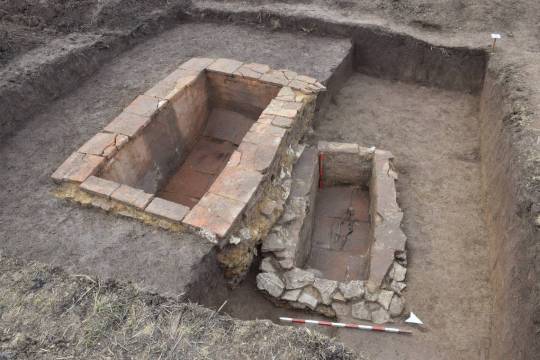
1,700-Year-Old Roman Tombs Discovered in Bulgaria
A farmer in Bulgaria accidentally discovered two graves of a wealthy Roman-era family, but they appear to tell "a sad family story."
Two large graves discovered in northern Bulgaria likely tell "a sad family story" about wealthy Roman landowners whose child predeceased them in the third century A.D., archaeologists say.
In December 2023, a farmer unexpectedly found the graves while plowing his field in the village of Nova Varbovka. Because this region was a Roman province called Moesia in antiquity, archaeologists from the Veliko Tarnovo Regional Museum of History came to excavate the graves.
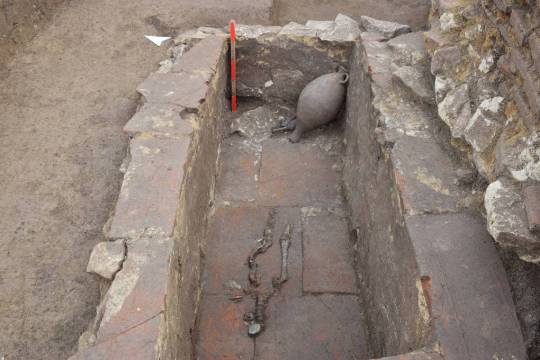
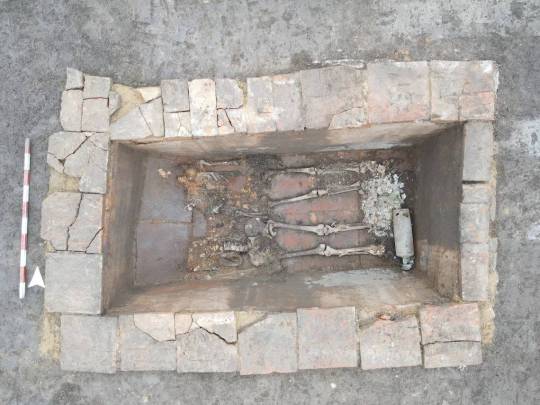
Both graves were built of brick, with plaster lining the walls and a large slab of limestone covering them. The larger of the two was roughly 10 feet (3 meters) long and contained the remains of two adults — a man and a woman who were both around 45 to 60 years old at death — buried with jewelry, coins, and ceramic and glass vessels.
The smaller grave, made somewhat earlier, contained the skeleton of a 2- to 3-year-old child and a rare bronze medallion depicting the Roman emperor Caracalla's (ruled A.D. 198 to 217) visit in A.D. 214 to Pergamon (also spelled Pergamum) in Asia Minor (modern-day Turkey), where he sought out the temple to Asclepius, the god of healing. Collectively, the two graves may represent a family's final resting place.
Some of the limestone from the graves appears to have come from a quarry near Nicopolis ad Istrum, a Roman and early Byzantine town founded by the emperor Trajan in the early second century. "This peculiarity and other indications make me think that the deceased are somehow related to the territory of Nicopolis ad Istrum," Kalin Chakarov, an archaeologist at the Veliko Tarnovo Regional History Museum, said in an email.
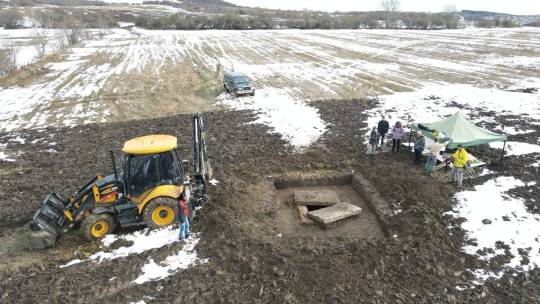
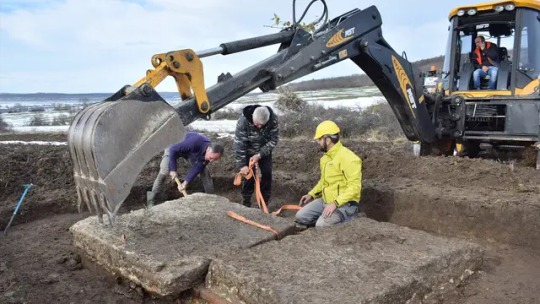
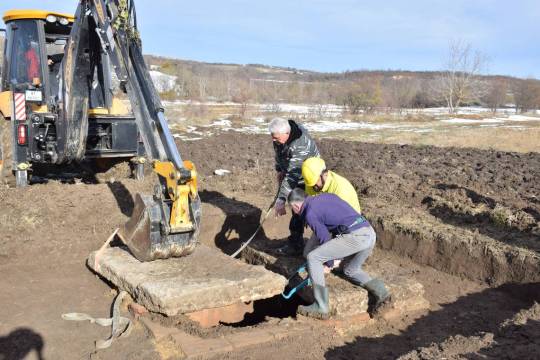

Chakarov, who excavated the burials along with colleagues Nedko Elenski and Mihaela Tomanova, noted that the Caracalla medallion could point to an Asia Minor origin for the occupants of the graves, which would be consistent with the fact that Nicopolis ad Istrum was built mainly by settlers from Asia Minor. "Of course, we are searching for an opportunity to make DNA and other analyses which our museum can't afford, to see if this hypothesis is correct," Chakarov said.
"The discovery of such tombs in the territory of Bulgaria is not a surprise, since the climate and soils are very good for growing agricultural crops," Ivan Tsarov, director of the Veliko Tarnovo Regional History Museum, said in an email. "Probably the tombs are of rich landowners," Tsarov said, since "it was the practice in Moesia Inferior for landowners to live in the warmer months of the year and be buried on their estates."
The artifacts discovered during the excavation are still being processed in the museum laboratory, where they are undergoing conservation and restoration, according to Tsarov. These include objects used during the deceased's lifetime, as well as those that would accompany them into the afterlife. In addition to jewelry made of glass beads and gold, there were six coins that dated to between A.D. 200 and 225, as well as a lamp, a leather shoe and several glass bottles, three of which were "lacrimaria," small flasks for collecting the tears of mourners.
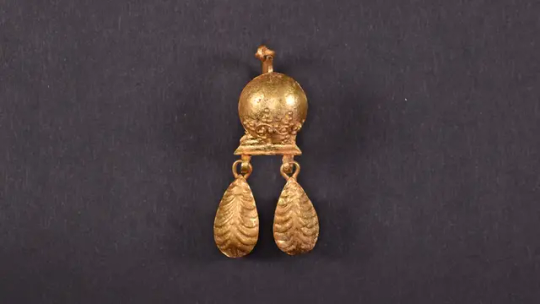

"I think that it is a sad family story from the first half of the 3rd century," Chakarov said. "A dead infant, buried by their parents, who had their last resting place on the same spot where they buried their child."
Chakarov plans to conduct work in the area to try to find where these people lived, which he thinks was likely close to this newly discovered cemetery.
By Kristina Killgrove.
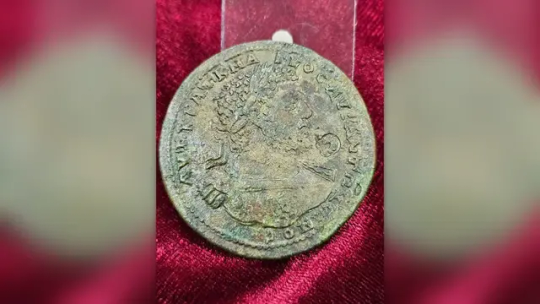
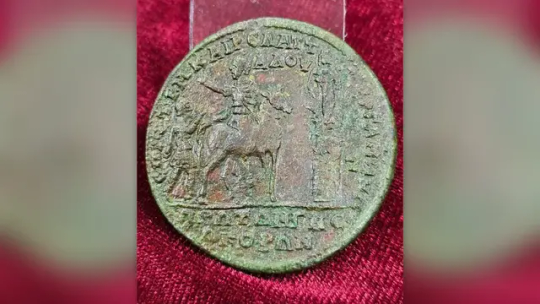
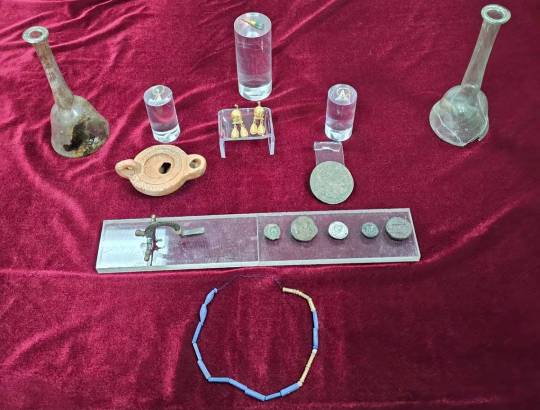
#1700-Year-Old Roman Tombs Discovered in Bulgaria#village of Nova Varbovka#Moesia#Emperor Caracalla#ancient grave#ancient tomb#ancient artifacts#archeology#archeolgst#history#history news#ancient history#ancient culture#ancient civilizations#roman history#roman empire
55 notes
·
View notes
Text
Coin of the Day #254 (1/13/2025)
RPC had this type misattributed as Elagabalus until this morning…


Roman Province - Moesia
AE17.5 - 3.28g
Caracalla 198-211 AD
Nicopolis ad Istrum Mint
Obverse AY K CE ANTΩN
Bust of Caracalla right, laureate, draped, cuirassed, from behind
Reverse NIKOΠOΛIT ΠPOC ICT
Eagle standing front on thunderbolt, holding wreath in beak
RPC V -
#coin of the day#roman empire#roman province#ancient rome#caracalla#emperor caracalla#nicopolis ad istrum#nicopolis#moesia#roman coins#numismatics#coin#coins#ancient coins
9 notes
·
View notes
Text
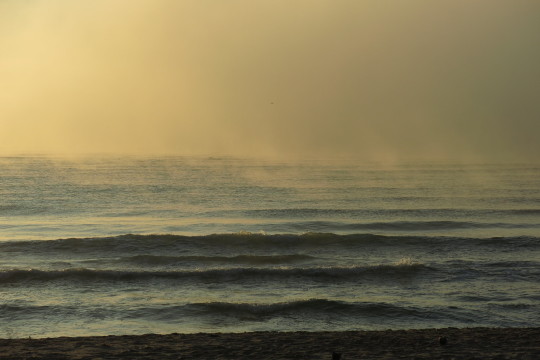


My Bulgaria - Foggy Morning in Varna - Black Sea (2) (3) by Lyura
#fog#coastal#ocean#beach#city overview#overlook#bulgaria#bulgarian black sea coast#bulgarian riviera#northern bulgaria#moesia#varna province
2 notes
·
View notes
Text
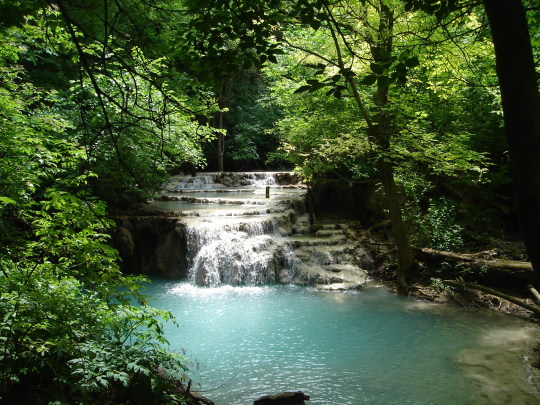
Krushuna Falls
1 note
·
View note
Text
Letture a Fiume IVᵃ edizione
Arrivo Aps, presenta: Letture a Fiume IVᵃ edizione Bosco didattico di Ponte Felcino, lungo il fiume Tevere Ingresso vicino all’ostello sabato 18 maggio 2024 dalle 13h30 Dopo Ponte San Giovanni, Pretola e Ponte Felcino, vista l’accoglienza trovata, quest’anno Arrivo Aps ha scelto di nuovo il bosco didattico per “Letture a fiume”, un evento che è innanzitutto spazio di incontro e…
View On WordPress
#arrivo aps#associazionismo#bosco#bosco didattico#cultura#fiume#letture#letture pubbliche#live painting#MOESIA#natura#Nicola Castellini#Perugia#poesia#ponte felcino#scrittura#volontariato
0 notes
Text
Coin of the Day #41 (6/14/2023)
Happy Pride Elagabalus!
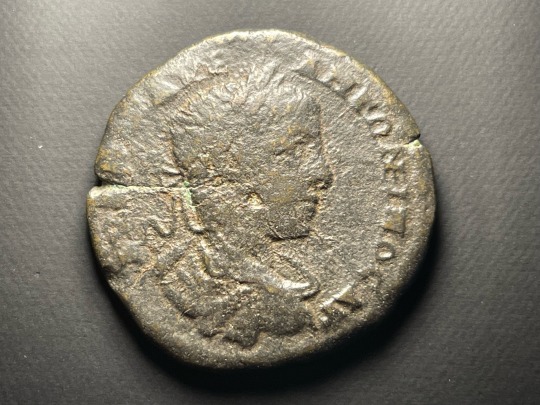
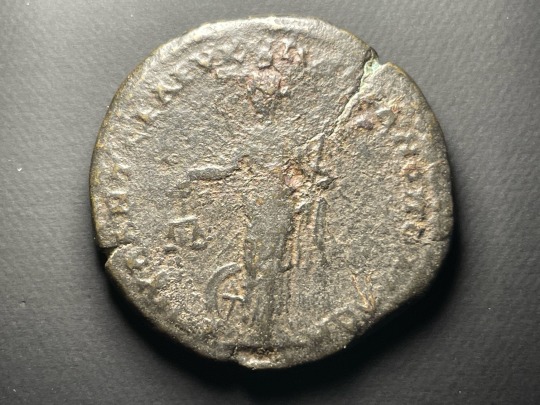
Roman Province - Moesia
AE25 - 6.72g
Elagabalus (+ Julius Antonius Seleucus) 218-222 AD
Marcianopolis Mint
Obverse ΑΥΤ Κ Μ ΑΥΡ ΑΝΤΩΝΕΙΝΟC ΑΥΓ
Bust of Elagabalus right, laureate, draped, cuirassed
Reverse ΥΠ ΙΟΥΛ ΑΝΤ CΕΛΕΥΚΟΥ ΜΑΡΚΙΑΝΟΠΟΛΙΤΩΝ
Nemesis standing left, holding scales and rod, wheel at feet
RPC VI 1484
happy pride to whatever the fuck elagabalus was doing
#coin of the day#roman empire#roman province#moesia#elagabalus#ancient rome#marcianopolis#roman coins#coin#coins#numismatics#pride month#ancient coins
20 notes
·
View notes
Text
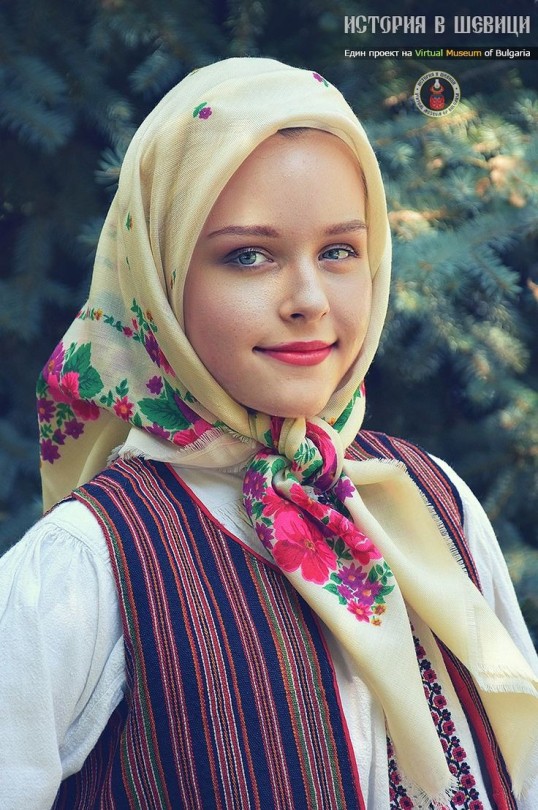

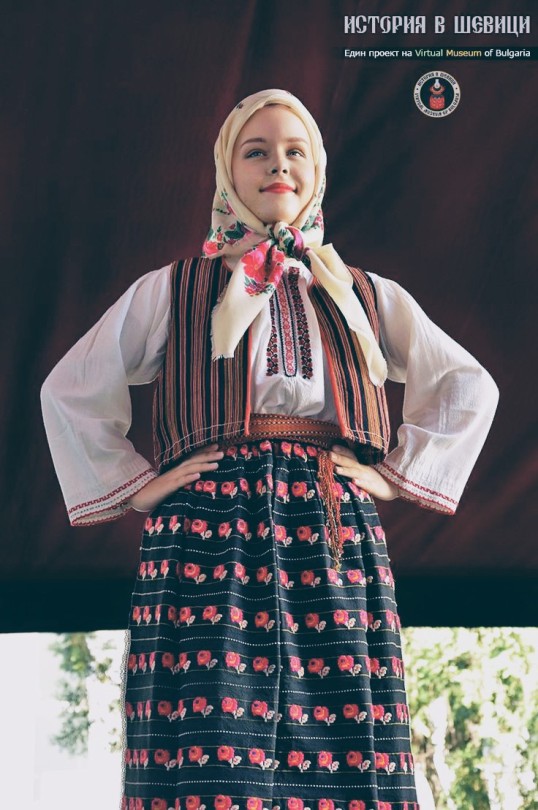

Bulgarian Catholic traditional clothing, Dragomirovo village, Svishtov province. | Носия на българи-католици от Букурещ, Румъния, завърнали се в България след Освобождението, понастоящем в с. Драгомирово, Свищовско.
Photos by Slavyan Stoyanov
2 notes
·
View notes
Text
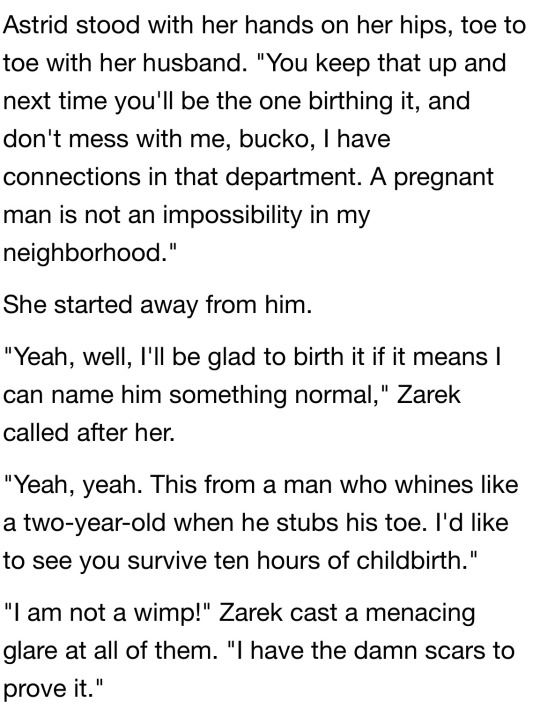
*chanting* trans trans trans trans
#kind of accepting there buddy#that's very transgender of him#what scars? huh bud?#top surgery?#coochie scars?#zarek of moesia#?#more like zarek of transgenderia#make him trans sherrilyn#do it
10 notes
·
View notes
Text
Roman Limes
Limes means road – originally, it really was a road connecting border fortifications with each other. Over time, it began denoting a geographically shaped or fortified border. It is incorrect to use limes as a term for all borders of the Roman Empire, though the world will sometimes be used in such a manner as well. System of border fortifications fulfilled its functions generally from 1st until…
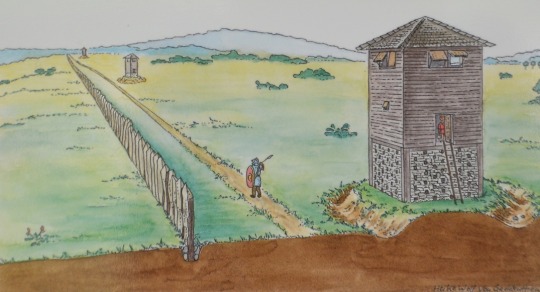
View On WordPress
#antonine wall#border wall#diocletians limes#hadrians wall#late roman limes#limes#limes africanus#limes alutanus#limes arabicus#limes britannicus#limes dacicus#limes germanicus#limes moesiae#limes orientalis#limes transalutanus#roman#roman limes#trajans wall
0 notes
Text
Roman Limes
Limes means road – originally, it really was a road connecting border fortifications with each other. Over time, it began denoting a geographically shaped or fortified border. It is incorrect to use limes as a term for all borders of the Roman Empire, though the world will sometimes be used in such a manner as well. System of border fortifications fulfilled its functions generally from 1st until…
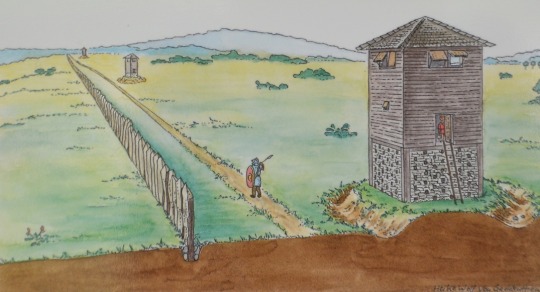
View On WordPress
#antonine wall#border wall#diocletians limes#hadrians wall#late roman limes#limes#limes africanus#limes alutanus#limes arabicus#limes britannicus#limes dacicus#limes germanicus#limes moesiae#limes orientalis#limes transalutanus#roman#roman limes#trajans wall
0 notes
Text

Roman Marble Statue Found in Bulgaria
Archaeologists uncovered a fully preserved statue from the ancient city of Odessos. Archaeologists from Regional History Museum in Varna (Bulgaria's biggest maritime city) reported this afternoon, October 15, about this exceptional find during the excavations of the ancient city - a marble sculpture from the Roman era, slightly taller than a human height.
It depicts a middle-aged man with a short beard, dressed in a toga, with a scroll in his hand. On the front of the pedestal there is a well-preserved inscription, and from a preliminary reading it is clear the name of the person depicted: G(ai) Marius Hermogenes.
The only part that is missing is the wrist and there is some minor damage to the face, so restoration is needed before it can go on display, Archaeologia Bulgarica said on its Facebook page.
The statue was discovered during construction work in an area of sandy deposits, outside the walls of the ancient city. It was promptly reported to the museum by construction contractor Georgi Kraychev. The sculpture is believed to be from the end of the 2nd and the first half of the 3rd century.




The present-day city of Varna, Northeastern Bulgaria, originated as a settlement named Odessos (Ὀδησσός) which was founded by Ionian colonists from Miletus around 600–550 BC. The Greeks established their colony on the site of an earlier Thracian settlement.
In 335 BC, Alexander the Great conquered almost the entirety of ancient Thrace, and Odessos became part of the Macedonian Kingdom.
Odessos flourished most significantlly during the Hellenistic Age (end of III – I BC), when the city served as a starting point of troops of the successor of Alexander the Great – king Lysimachus (323–280 BC) who proclaimed himself king of Thrace. Big public buildings like temples, theatre, gymnasium (school for boys) and others were built during this period. Due to the increase of Thracian population in the city, a temple of the Thracian god-rider Heros Carabazmos and a temple of Artemis Phosphoros were built in II – I BC.
In 15 AD, Odessos became part of the Roman Empire, in the province of Moesia (later Lower Moesia), and became its main port on the Black Sea (Pontus Euxinos). Huge and ornate warm baths (Roman baths), the fourth largest in Europe, were built 7000 square meters of land.
It was called Varna by the Ancient Bulgars after the First Bulgarian Empire conquered it in the late 7th century AD.

#Roman Marble Statue Found in Bulgaria#Varna Bulgaria#ancient city of Odessos#G(ai) Marius Hermogenes#marble#marble statue#marble sculpture#ancient artifacts#archeology#archeolgst#history#history news#ancient history#ancient culture#ancient civilizations#roman history#roman empire#roman art#ancient art#art history
62 notes
·
View notes
Text
Coin of the Day #242 (1/1/2025)
Happy 2025! Throwback to 225 here…


Roman Province - Moesia
AE25 - 8.97g
Severus Alexander 222-235 AD
Marcianopolis Mint
Obverse AYT K M AYP CEYH AΛEΞANΔPOC
Bust of Severus Alexander right, laureate, draped, cuirassed, from behind
Reverse YΠ TIB IOYΛ ΦHCTOY MAPKIANOΠOΛITΩN
Demeter standing front, holding corn ears and cornucopiae
RPC VI 1638
#coin of the day#roman empire#roman province#ancient rome#severus alexander#marcianopolis#moesia#roman coins#numismatics#coin#coins#ancient coins#demeter
2 notes
·
View notes
Photo

Legions of Pannonia
Located west of the Danube, Pannonia was essential for the protection of the Roman Empire's eastern frontier. It had been occupied since 9 BCE but did not willingly accept Roman authority. Pannonia and Dalmatia revolted in 6 CE, and it would take three years and a total of eleven legions to finally bring Roman victory in 9 CE. To ensure peace, four legions were assigned to Pannonia: X Gemina, XIV Gemina, I Adiutrix, and II Adiutrix.
The Pannonian Revolt
After years of conflict with Rome, Pannonia had finally fallen under Roman control in 9 BCE. The uneasy peace that followed would not last long. After the Roman commander and future emperor Tiberius (r. 14-37 CE) withdrew legions from Pannonia and Dalmatia for his Germanic campaign in 5 CE, the two provinces seized the opportunity to rise up and revolt. The Pannonian rebel army struck first, marching into Macedonia. Meanwhile, Dalmatian rebels began to raid neighboring towns, attacking Roman auxiliaries and massacring Roman citizens. With this initial success, more and more Dalmatians joined in the cause. Eventually, the rebels would number over 200,000 – one-fourth of their combined population. Although surrounded by the rebellious army, the governor of Dalmatia, Marcus Messalinus, and cohorts of the 20th legion were able to rout the rebels. After the Pannonians laid siege to Sirmium (in modern Serbia), the governor of Moesia, Caecina Severus, and his legions marched westward to meet the Pannonian commander and his army and defeated him.
With the Dalmatian attack on Salonae (in modern Croatia) and much of the Adriatic coast in rebel control, panic across Italy forced the Roman emperor Augustus (r. 27 BCE - 14 CE) to recall Tiberius. With Legio VIII Augusta, Legio XI Hispana, Legio XIV Gemina Martia Victrix, Legio XV Apollinaris, and cohorts of the Legio XX, he marched into the rebelling provinces. In addition to Tiberius, Augustus sent the young Germanicus (15 BCE - 19 CE) to the Balkans with a force of evocati and non-citizen troops. Meanwhile, Aulus Caecina Severus and Plautius Silvanus arrived from the East with five legions. In total, the Roman army numbered 10 legions, 70 cohorts of auxiliary, 14 cavalry wings, and 10,000 evocati.
The Pannonians abandoned their plan to march on Rome, and the Dalmatian commander grew suspicious of his counterpart's loyalty to the cause. The Pannonian leader was captured, put on trial, found guilty, and executed. After this, the Roman army laid siege to several Dalmatian towns. Casualties were high on both sides, and it took one-third of the Roman army to finally suppress the uprising. Before the Dalmatian commander was led off to live the remainder of his life in house arrest, he had one final comment, blaming Rome for the war: "We are your flocks, yet you didn’t send shepherds to look after us, you sent wolves." (quoted in Dando-Collins, 234) Writing years later, the historian Suetonius (c. 69 - c. 130/140 CE) wrote in his biography of Tiberius about the seriousness of the rebellion. He said the revolt "proved to be the most bitterly fought of all foreign wars since Rome had defeated Carthage" (Twelve Caesars, 114).
In his The Complete Roman Legions, historian Nigel Pollard places four legions permanently in Pannonia:
Legio X Gemina
Legio XIV Gemina
Legio I Adiutrix
Legio II Adiutrix
Continue reading...
32 notes
·
View notes
Text
CONSTANTINE THE GREAT
CONSTANTINE THE GREAT
c.272 - 22 May 337 CE
ROMAN EMPEROR WHO CONVERTED TO CHRISTIANITY
Constantine was born in Naissus, Moesia (Serbia) and campaigned against the Persians and was with his father in Britannia. Constantine was declared Emperor of Rome by his father’s soldiers in York, England after his father died in 306. Constantine had to deal with civil wars, and had to overcome rivals such as the Eastern Emperor Licinius who he eventually defeated.
Constantine became Christian in 312 and was the first Christian Empeor of Rome. He allowed freedom through the empire, which put the end of persection for Christians. He was also the one who established the unity of church and state. He had the Church of the Holy Sepulchre built in Jerusalem on the apparent site of Jesus’ tomb.
Constantine became ill and knew he was near death and had a final resting-place prepared for himself and spent his last days praying. He died aged 65. Constantine was buried in the Church of the Holy Apostles, his tomb and body was destroyed not long after the Fourth Crusade in 1204.

#constantine #constantinethegreat #ancientrome
3 notes
·
View notes
Text
Arrivo In Festa
E’ da un pò che non ci sentiamo, come va? Qui dalle nostre parti a gonfie vele, con vento leggero e piacevole. Primaverile. E’ con delicatezza che vi invitiamo all’evento Arrivo InFesta link facebook: https://www.facebook.com/events/1618199712264643 per chi non ha facebook condividiamo le seguenti informazioni: il giorno di venerdì 29 marzo dalle ore 19:30 aperitivo con intro a cura di…

View On WordPress
0 notes
Note
What brought you to focus on Thasos?
It really took this question to realize I never addressed this, even though I thought I did. In short, it all came down to one inscription found on the island.
The inscription itself has long been considered “unpublished”, which in this case meant it had been translated once, in French, in the 1960s, by the archaeologists and historians who were working on excavating Thasos at the time. In the 90s, Swiss historian Anne-Francoise Jaccottet wrote a thesis on Dionysiac associations in the Greco-Roman world, and that’s where I found it first. Getting my hands on the thesis alone was a strike of luck, since when I began looking for it (because I saw it often cited in papers I’d read) it was only available on command from the university for a price in the 100s of euros. Until, in 2020, the author herself put the whole thing on academia.edu for free. Happenstance and all that.
Anyway, the reason why this particular inscription caught my attention out of the whole corpus of documents in the thesis was that it described vividly something linked to a UPG I had months prior. At the time I took note of the inscription as something to come back to later because I wasn’t sure what to do with the info. Confirmation was nice, but truly had no idea what to do with it.
A year or so later, I noticed that the same author had written and - again - put online for free, an article from 2018 on that specific inscription in collaboration with Stephanie Wyler (whose line of work tends to revolve around Dionysus in the roman context) and on the same element that resonated with my UPG. That is, the idea of a canopy of greenery/vines as an important ephemeral setup for worship, which is something that we can also catch glimpses of in literature:
“The flame, dividing, dimly outlines a cave for Dionysus more charming than any in Assyria and Lydia; for sprays of ivy grow luxuriantly about it and clusters of ivy berries and now grape-vines and stalks of thyrsus which spring up from the willing earth, so that some grow in the very fire.” - Philostratus the Elder, Imagines 1.13 (or 1.14 on theoi.com), 3rd century AD
The Thasian inscription, however, dates back from the 1st century AD and is a private dedication of a sanctuary to Dionysus from a man named Timokleides. He is described as being a doctor from Thasos and as being at the head of the dionysiac association (thiasos) that would be using this sanctuary. I could do a whole post about this alone, but the point is that it’s from there that I got the hutch to look at where the inscription came from in the first place.
That research led me to the realization that it was a very documented island, in big part because it has been excavated for decades but also because the ancient city/island used to be renowned for its wine, its marble and its gold, thanks to nearby mines on the Thracian coast. It led me to see that the calendar was in a workable state, that we had a decent list of attested festival and a very fair number of smaller sacrifial rules and miscellaneous inscriptions.
Another, more personal, reason why Thasos was a good fit was the geographical proximity with Lampsakos, Thrace and Moesia Inferior where I have (limited) elements concerning the presence of Priapus. Thasos is also known for having important examples of thysia, that is sacrifices for heroes in which the sacrifices were eaten by the worshippers, which goes against what is typically described as the norm in ancient Greek religion on a larger scale, but which also line up more closely with my personal experience.
All of these factors combined made Thasos a particularly good match for me. It felt a lot like finally putting together mismatched pieces of information into something that made sense.
#this is a mess of a post because there's just so many small little things#but overall it just worked out very well#thasian recon
25 notes
·
View notes